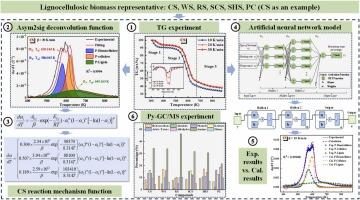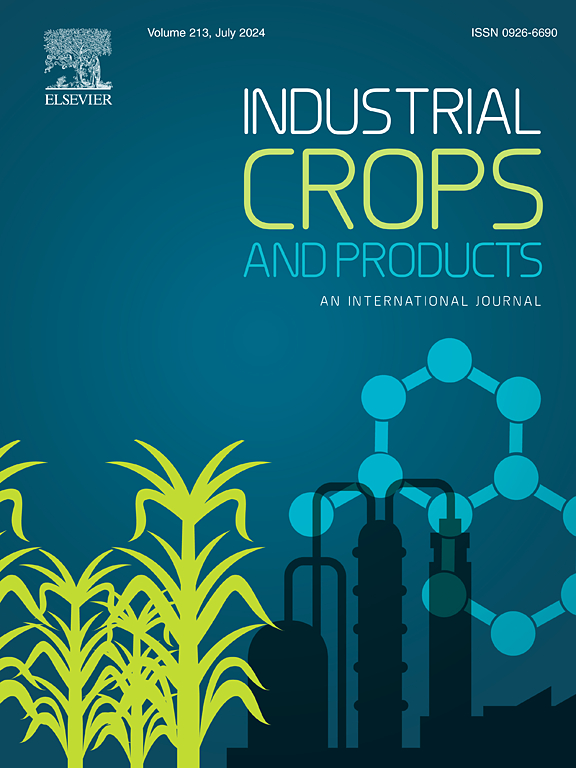利用三平行反应模型、组合动力学、Py-GC/MS 和人工神经网络研究木质纤维素生物质热解的动力学、反应机理和产物分布
IF 5.6
1区 农林科学
Q1 AGRICULTURAL ENGINEERING
引用次数: 0
摘要
生物质热解是生产可再生能源的关键过程,也是化石燃料的可持续替代品。本研究使用同步热分析仪、热解-气相色谱/质谱仪(Py-GC/MS)、液相核磁共振(NMR)光谱仪和 X 射线光电子能谱仪(XPS)分析了六种具有代表性的木质纤维素生物质的热解过程和产物成分。此外,根据 TG 结果,使用动力学建模、三重平行反应模型和 Asym2sig 解卷积函数探讨了六种生物质中三种成分的热解动力学。随后,使用组合动力学方法建立了六种生物质的动力学模型。最后,建立了一个人工神经网络(ANN)模型来预测所研究生物质的热解行为。例如,玉米秸秆(CS)显示了三个主要热解阶段:400 K 以下(小分子挥发)、400-670 K(主要成分分解)和 670 K 以上(残余成分炭化和中间产物二次分解)。CS 成分的最佳动力学模型为:f1(α1) = α1-0.80697 (1 - α1)1.99689 [-ln(1 - α1)]1.15425, f2(α2) = α20.43522 (1 - α2)1.29066 [-ln(1-α2)]0.32644,f3(α3) = α3-2.82644 (1 - α3)3 [-ln(1-α3)]-1.87480。此外,ANN23 的 R2 值最高(0.99908)。因此,ANN23 是预测 CS 高温分解的最合适模型。本研究为生物质热解提供了有价值的参考。本文章由计算机程序翻译,如有差异,请以英文原文为准。

Kinetics, reaction mechanism and product distribution of lignocellulosic biomass pyrolysis using triple-parallel reaction model, combined kinetics, Py-GC/MS, and artificial neural networks
Pyrolysis of biomass is a crucial process for the production of renewable energy and a sustainable alternative to fossil fuels. The present study analyzed the pyrolysis process and the composition of the products of six representative lignocellulosic biomasses using simultaneous thermal analyzer, pyrolysis - gas chromatography/mass spectrometry (Py-GC/MS), liquid-phase nuclear magnetic resonance (NMR) spectroscopy and X-ray photoelectron spectrometer (XPS). Furthermore, based on the TG results, the kinetics of the pyrolysis of three components of the six biomasses were explored using kinetic modelling, triple-parallel reaction model and Asym2sig deconvolution function. Subsequently, kinetic models of the six biomasses were developed using a combinatorial kinetic method. Finally, an artificial neural network (ANN) model was developed to predict the pyrolysis behaviors of the studied biomasses. For example, corn straw (CS) revealed three primary pyrolysis stages: below 400 K (volatilization of small molecules), 400–670 K (decomposition of major components), and above 670 K (charring of the residual components and secondary decomposition of intermediates). The optimum kinetics models for CS components were: f1(α1) = α1−0.80697 (1 − α1)1.99689 [−ln(1 − α1)]1.15425, f2(α2) = α20.43522 (1 − α2)1.29066 [−ln(1 − α2)]0.32644, and f3(α3) = α3−2.82644 (1 − α3)3 [–ln(1 − α3)]−1.87480. Moreover, ANN23 showed the highest R2 value (0.99908). Therefore, ANN23 is the most suitable model for predicting the pyrolysis of CS. The present research provides valuable references for the pyrolysis of biomass.
求助全文
通过发布文献求助,成功后即可免费获取论文全文。
去求助
来源期刊

Industrial Crops and Products
农林科学-农业工程
CiteScore
9.50
自引率
8.50%
发文量
1518
审稿时长
43 days
期刊介绍:
Industrial Crops and Products is an International Journal publishing academic and industrial research on industrial (defined as non-food/non-feed) crops and products. Papers concern both crop-oriented and bio-based materials from crops-oriented research, and should be of interest to an international audience, hypothesis driven, and where comparisons are made statistics performed.
 求助内容:
求助内容: 应助结果提醒方式:
应助结果提醒方式:


